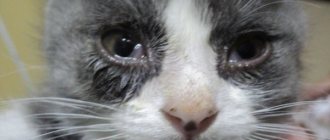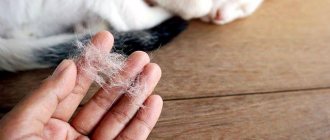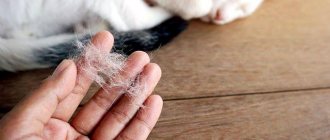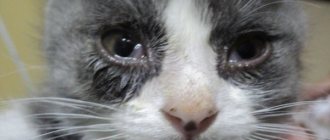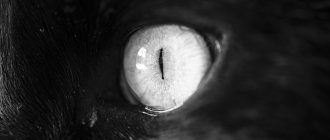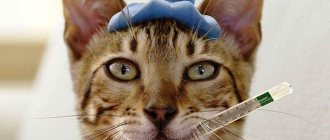Usually the owner treats the four-legged pet as a full-fledged member of the family. At times he worries about his health more than his own.
And this is justified, since the cat cannot say that something is bothering it. This happens, for example, when he breaks his paw. What to do in such a situation is below in the article.
Broken paw
Causes of fractures
A cat's paw fracture occurs for the following reasons:
- jump from height;
- receiving various injuries (inflicted by humans or animals);
- domestic injuries (mostly accidental);
- specially bred rare breeds do not have excellent health. They often have pathological bone fragility, which makes injuries much more common;
- infection, congenital pathologies, imbalances. Various external factors that weaken immunity and bone strength are taken into account.
For your information! The majority of fractures in felines occur in the limbs. Then in frequency there are fractures of the pelvis, tail and spine. The rarest is a skull fracture.
How to recognize a fracture or bruise of a hind paw
Examination of the hind paw.
The wound may be between the joints or on the inner surface of the pad, between the cat's toes. It happens that during a jump the animal pushes off the surface incorrectly. In this case, joint dislocation and ligament sprain are almost always guaranteed. Cats who are obese and lead a sedentary lifestyle are most susceptible to such damage.
Fracture of the hind leg of a cat on ultrasound.
The joints of such animals are poorly developed and with a strong push or sudden movement the risk of injury increases. A dislocation, sprain, or bruise may have slight swelling and be quite painful when pressed.
What to do if your cat is limping on its hind leg without visible damage
Severe swelling of the paw.
Upon closer examination, swelling becomes visible, the paw is hot and painful. A significant reason is pathology in the formation of the joint. When the kitten is still small, the symptom of lameness is rarely observed. The baby's weight is insignificant, which means the load on the paws is also small. As people get older, lameness becomes more noticeable.
Lameness in a cat
Another reason for lameness in a cat is due to diseases such as arthritis or arthrosis. Arthritis appears as the animal gets older. The influence on the body of external factors that provoke infectious diseases worsens with age, which makes it possible for inflammatory processes in the joints to manifest themselves.
The older the cat, the greater the likelihood of exacerbations of the disease, which is accompanied by periodic pain and, as a result, lameness.
Arthrosis
The cat is limping on its hind leg due to arthrosis.
It can proceed hidden for a long time, since degenerative changes in tissues, bones and cartilage occur gradually. There are many reasons, the most common is a congenital anomaly of the anatomical structure.
As with arthritis, adult felines are most susceptible, but there are exceptions when the congenital changes are too extensive. Then lameness is observed in young animals.
Traumatic arthrosis
Complex case.
Arthrosis can be traumatic. The cat was injured while walking; there were no obvious symptoms; over time, the bruised tissues, bones, and cartilages begin to rebuild incorrectly. Do not discount lumbar back injuries.
The pet could have been hit during a walk, or it could have landed poorly during a fight with other animals, dogs, for example. With a traumatic injury to the back, nerve endings may be pinched, which causes discomfort when walking.
Classification of fractures
The cat's eyes are watery: what to do at home
There are many fractures, mainly divided into open and closed. Regardless of the type of injury, you do not need to treat the damaged paw yourself, much less set it. It is also better not to touch the cat or bother him over trifles. Such actions will worsen his well-being and provoke a state of shock. Or even worse, they will change the location of the bone, increasing the pain.
- Open fracture in a cat. An open fracture is characterized by breaks in the skin where the bone may be visible.
- Closed fracture. A closed fracture is characterized by unchanged skin, the place at first looks like a bruise.
How to tell if a cat has broken its paw
The main symptom of damage to the front or hind legs is limping, but the cat could have bruised the limb. Upon examination, a bruise may be detected or palpation may cause pain to the animal.
Fracture: treatment and care
Closed fractures are treated with conservative methods. After the initial examination and x-rays, the veterinarian fixes the limb with a plaster.
For a speedy recovery, I prescribe for my pet: a regime of maximum limitation of mobility, vitamin supplements, means to strengthen bone tissue, and physical therapy.
Be sure to read:
Vaccinations for cats: what they are needed for, when and which ones are given, table by age, pros and cons
Open fractures require surgery. The veterinarian sets the bone, removes fragments, and fixes the damage with a pin or knitting needle. The animal is prescribed antibiotics and vitamins.
During the rehabilitation period, the owner should limit the pet’s mobility by placing it in a spacious container. After removing the cast, massage the healed paw daily and introduce foods that promote osteosynthesis (bone tissue regeneration) into the diet.
The cat broke its paw, what to do at home
If there is a suspicion that your pet has a fracture, it is important not to panic, not to feed the animal with available medications and not to solve the problem yourself by providing first aid.
Urinary incontinence in a cat: what to do at home
If your cat suddenly breaks its paw, you need to immediately take it to a veterinary clinic. If the fracture is open, the first step is to stop the bleeding. The arterial is stopped with a tourniquet, and the venous with a bandage, making a bandage.
Note! The injury itself cannot heal.
A small kitten broke its leg, what should I do? You will have to transport the injured pet to the hospital, preparing a hard sleeping place. It is best to apply a bandage to the injured paw.
So what to do if your cat breaks his paw?
First, you need to call the clinic where your pet will receive qualified medical care and make an appointment. First, they will diagnose you using x-rays and prescribe appropriate therapy.
Limb fixation
After calling the clinic, the animal will be transported. When providing first aid, they try to properly immobilize the limb by applying a tight bandage, splint or bandage. If there is a fracture of a cat’s paw, especially the front one (regardless of the exact location of the damage), possibly with displacement, then you need to carefully immobilize the cat’s paw, fixing it. The main thing is not to cause associated injuries and not to worsen the existing problem.
At home, a splint is made from a hard material (you can take a plastic or wooden object) and secure it tightly with a bandage.
Note! If a cat with an injury is aggressive, you should not even try to fix the broken leg; you need to put him in a carrier and bring him to the clinic.
To transport a cat to a veterinary clinic, you need to place it in a rigid transport container and close it. It is important to use a hard surface, especially if spinal fractures are suspected.
How to find out?
First of all, you should pay attention to the changed behavior of the animal:
- becomes apathetic;
- prefers to lie down more;
- hiding;
- refuses food;
- limps;
- rises heavily to his feet;
- cannot stand up (pelvic fracture).
However, if a cat moves on three legs, this does not mean that it necessarily has a fracture. Perhaps a splinter got into the paw, making it painful to step on, a dislocation occurred, or the cat was injured or hurt.
Before administering first aid, carefully inspect the paw. A fracture is indicated by:
- strong pain;
- unnatural bone mobility;
- anatomically incorrect placement of the limbs (turned in the opposite direction);
- edema, swelling;
- crunch when palpated.
Upon examination, the cat will most likely scream and try to escape. Be kind to your pet. Before examination, calm the animal and place it on your lap. Try not to squeeze the paw too hard, gently probing with two fingers.
Is a hospital needed for a cat with a fracture?
Diarrhea and vomiting in a cat: what to do at home
The postoperative period for a pet includes hospitalization of the cat until the owner is able to provide adequate control over its well-being. In the hospital, the pet undergoes all the necessary procedures, for example, injections, oxygen therapy or IVs, etc.
After providing pain relief and first aid, veterinarians will carry out the remaining diagnostic measures. If possible, the cat's condition will be checked twice a day. In the morning, take blood and secretions for testing.
Recovery in hospital
Veterinarians administer painkillers to an animal with a fracture in a state of traumatic shock, available only to doctors in a hospital. It will not be possible to organize treatment for a cat at home, since fast-acting drugs are not sold without a doctor’s prescription.
Diagnostics in a veterinary clinic
Diagnosis in a veterinary clinic should be aimed at identifying associated disorders, for example, hormonal imbalances, which may adversely affect the health of the animal. Serious pathologies are a contraindication for surgery. Activities aimed at treating a feline fracture include: initial examination, collection of tests (biochemistry), x-ray of the limb in several projections, ultrasound of the heart and other organs.
For your information! Polytrauma—several fractures—is often encountered in veterinary practice.
An orthopedic veterinarian will conduct a comprehensive examination, after which he will assess the sensitivity of the damaged paw and check the reflex. After this, the doctor will make sure that there are disorders that are associated with problems of the musculoskeletal system.
X-ray of a fracture
Then he proceeds to the next step - palpation. He palpates the paws and gives the animal pain relief. After identifying the problem area, the doctor begins a special examination method - radiography. X-rays are an effective and inexpensive way to examine a fracture in your pet.
What types of damage are there?
Most often in animals, it is the radius bone that is damaged.
Among fractures, the most common injury is the radius bone, since the front legs bear the main load during landing. Varieties:
- Injury. It is characterized by compression of the soft tissues of the paw if the cat hits it, but the bone structures remain unharmed.
- Dislocations. The articular head is displaced from the articular capsule. The condition is often combined with a fracture.
- Closed injury. The bone is broken without breaking the integrity of the skin.
- Open fracture. Bone structures break and fragments pierce the skin.
In addition, fractures are of the following types:
- Fragmentation. The bone is crushed into several fragments.
- Multiple. The bone structure is broken in several places.
- Single. The paw is only broken in one place.
Conservative method
Non-surgical therapy begins with an anesthetic. Afterwards, if necessary, the dislocation is reduced and a splint, a plaster cast, and a collar are applied to fix the damaged paw. Much depends on the cat’s behavior, since with aggressive behavior it will not be possible to complete the required steps properly.
Subsequent steps include prescribing medications to the animal to help restore bone tissue and relieve inflammation.
Note! The newest hospitals use effective physical therapy, which allows you to count on a speedy recovery and improved health.
When is surgery needed?
There are many reasons that will determine how to treat a fracture in a cat. The most important of them are the general health of the pet, the age of the pet, the type of injury and what bones it broke. At times, for injuries to the hind legs, a fixing bandage or splint is sufficient. If surgical intervention is still necessary, then a screw, pin (metal rod), wire or metal plate is installed into the cat’s bone to hold the bone fragments.
Treatment of injury is most often surgical; it includes fixation of bone fragments and ensuring stable preservation of the functions of damaged tissues. After surgical intervention, doctors prescribe therapeutic measures aimed at eliminating inflammation around the injury, healing and restoring the general condition.
Fracture treatment
Caring for a cat after surgery
During recovery, limit physical activity (including walks), visit a veterinarian as prescribed, give the cat vitamins, or, if the doctor recommends, switch the animal to health food, which helps restore bone tissue and regeneration.
If the veterinarian has applied a splint, cast or bandage, the owner must constantly monitor the bandage so as not to cause complications in the animal. The dressing should normally look like its original condition and be completely dry. Also, the condition of the tire is examined by a veterinarian at least three times a month.
Note! After visiting the veterinarian, the main thing is to follow his instructions. Also, after the cast and wires are removed, you need to allow time for recovery. According to experts, this may take more than a month. Recovery is monitored using radiography.
What are the characteristics of different types of fractures?
Previously, we looked at the actions of cat owners and veterinarians in the event of a “paw fracture” - that is, a fracture of the long tubular bones of the limbs. In a cat, these are the following types of fractures with their symptoms and treatment: hip fractures - that is, the femur, as well as the neck and head of the femur, tibia fractures - the tibia and fibula, humerus fractures - the humerus and forearm fractures - the radius and ulna. . These types of fractures are encountered most often in the practice of a veterinary traumatologist. Let us now move on to the nuances characteristic of other types of fractures.
Prevention measures
The largest number of fractures are caused by injury, so it is better to limit the time the cat spends in the fresh air. This will minimize the risk of injury from cars and eliminate the possibility of encountering other animals. It is worth paying attention to the behavior and habits of your pet when he comes back from a walk.
The cat broke his paw
The most common injury among domestic cats is a broken paw, most often the hind paw. Fluffy pets often go for walks unattended, sleep under cars, walk on window sills or climb tall trees. All of the above can cause a fracture.
All owners love their animals and become confused and scared, not knowing what to do in a given situation. The main thing is to gather your thoughts and, in case of such injuries, urgently call a specialist. The veterinarian will provide first aid and save the pet.
How to organize transportation of a cat to a veterinary hospital
To transport a cat with a broken bone, you need to prepare a hard, flat surface. Plywood, wide boards, and thick cardboard are suitable for this. The animal is placed on it and carefully tied with belts, belts, rope at the level of the shoulder blades and pelvis, holding the injured limb to reduce the pain of the pet. Transportation is carried out in the back seat of the car.
It is recommended that two people do this. One of them holds the animal, and the second carefully fixes it in a lying position on a hard surface.


